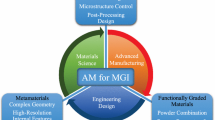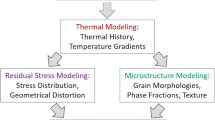Abstract
In this study, an overview of the computational tools developed in the area of metal-based additively manufactured (AM) to simulate the performance metrics along with their experimental validations will be presented. The performance metrics of the AM fabricated parts such as the inter- and intra-layer strengths could be characterized in terms of the melt pool dimensions, solidification times, cooling rates, granular microstructure, and phase morphologies along with defect distributions which are a function of the energy source, scan pattern(s), and the material(s). The four major areas of AM simulation included in this study are thermo-mechanical constitutive relationships during fabrication and in-service, the use of Euler angles for gaging static and dynamic strengths, the use of algorithms involving intelligent use of matrix algebra and homogenization extracting the spatiotemporal nature of these processes, a fast GPU architecture, and specific challenges targeted toward attaining a faster than real-time simulation efficiency and accuracy.

















Similar content being viewed by others
References
T.J.R. Hughes: The Finite Element Method: Linear Static and Dynamic Finite Element Analysis, Courier Dover Publications, Mineola 2012.
J.N. Reddy: An Introduction to the Finite Element Method, McGraw-Hill New York, 1993.
B.A. Szabo, and I. Babuška: Finite Element Analysis, Wiley, New York, 1991.
ASTM Standard, Annual book of ASTM standards 2004, vol. 3, pp. 57-72.
YC Chen and K Nakata, Materials & Design 2009, vol. 30, pp. 469-474.
R Filip, K Kubiak, W Ziaja and J Sieniawski, Journal of Materials Processing Technology 2003, vol. 133, pp. 84-89.
HK Rafi, D Pal, N Patil, TL Starr and BE Stucker, Journal of Materials Engineering and Performance 2014, vol. 23, pp. 4421-4428.
N Kumar, RS Mishra, CS Huskamp and KK Sankaran, Materials Science and Engineering: A 2011, vol. 528, pp. 5883-5887.
G Lütjering, Materials Science and Engineering: A 1998, vol. 243, pp. 32-45.
Z.Y. Ma, S.R. Sharma and R.S. Mishra: Scripta Mater. 2006, vol. 54, pp. 1623–1626.
RS Mishra, SX McFadden, RZ Valiev and AK Mukherjee, JOM 1999, vol. 51, pp. 37-40.
K. Zeng, D. Pal, and B.E. Stucker: in Solid Freeform Fabrication Symposium, (Austin, TX, 2012).
I. Gibson, D.W. Rosen, and B. Stucker: Additive Manufacturing Technologies, Springer, New York, 2010.
D. Pal, N. Patil, K. Zeng, C. Teng, S. Xu, T. Sublette, and B.E. Stucker: in Proceedings of the Solid Freeform Fabrication Symposium, Austin, TX, 2014.
N. Patil, D. Pal, and B.E. Stucker: in Proceedings of the Solid Freeform Fabrication Symposium, Austin, TX, 2013.
D. Pal, N. Patil, and B.E. Stucker: in Additive Manufacturing Consortium, Lawrence Livermore National Laboratory, 2014.
D. Pal, N. Patil, K. Zeng and B.E. Stucker: J. Manuf. Sci. Eng., 2014, vol. 136, pp. 061022.1−061022.16
Thermocalc, “Thermocalc for Windows” (Thermocalc, 2014), http://www.thermocalc.com/media/8139/tcw_examples.pdf 31st Dec 2014.
Thermocalc, “TC-Prisma User Guide and Examples” (Thermocalc, 2014), http://www.thermocalc.com/media/6045/tc-prisma_user-guide-and-examples.pdf 31st Dec 2014.
D. Pal and B. Stucker, Journal of Applied Physics 2013, vol. 113, p. 203517.1–203517.8.
D. Pal, S. Behera, and S. Ghosh: in United States National Congress on Computational Mechanics, 2009.
M Matsumoto, M Shiomi, K Osakada and F Abe, International Journal of Machine Tools and Manufacture 2002, vol. 42, pp. 61-67.
M Shiomi, A Yoshidome, F Abe and K Osakada, International Journal of Machine Tools and Manufacture 1999, vol. 39, pp. 237-252.
F Verhaeghe, T Craeghs, J Heulens and L Pandelaers, Acta Materialia 2009, vol. 57, pp. 6006-6012.
MF Zaeh and G Branner, Production Engineering 2010, vol. 4, pp. 35-45.
K Dai and L Shaw, Acta Materialia 2004, vol. 52, pp. 69-80.
S Kolossov, E Boillat, R Glardon, P Fischer and M Locher, International Journal of Machine Tools and Manufacture 2004, vol. 44, pp. 117-123.
IA Roberts, CJ Wang, R Esterlein, M Stanford and DJ Mynors, International Journal of Machine Tools and Manufacture 2009, vol. 49, pp. 916-923.
A Hussein, L Hao, C Yan and R Everson, Materials & Design 2013, vol. 52, pp. 638-647.
T.H.C. Childs, C. Hauser, and M. Badrossamay: in Proceedings of the Institution of Mechanical Engineers, Part B: Journal of Engineering Manufacture 2005, vol. 219, pp. 339–57.
D Deng and H Murakawa, Computational materials science 2006, vol. 37, pp. 269-277.
H Ding and YC Shin, Journal of Manufacturing Science and Engineering 2014, vol. 136, p. 041003.1–11.
L Ding, X Zhang and CR Liu, Journal of Manufacturing Science and Engineering 2014, vol. 136, p. 041020.
W Hammami, G Gilles, AM Habraken and L Duchêne, International journal of material forming 2011, vol. 4, pp. 205-215.
F Bridier, DL McDowell, P Villechaise and J Mendez, International Journal of Plasticity 2009, vol. 25, pp. 1066-1082.
N.R. Barton, J.V. Bernier, R.A. Lebensohn, and A.D. Rollett: in Electron Backscatter Diffraction in Materials Science, Springer, New York, 2009, pp 155–67.
B.E. Stucker, K. Zeng, S. Xu, N. Patil, C. Teng, T. Sublette, and D. Pal: in Proceedings of the Solid Freeform Fabrication Symposium, Austin, TX, 2014.
D. Pal and B.E. Stucker: in Proceedings of the Solid Freeform Fabrication Symposium, Austin, TX, 2012.
J Zhang and L Zhang, Mathematical Problems in Engineering 2013, vol. 2013, pp. 1-12.
J.C. Simo and T.J.R. Hughes: Computational Inelasticity, Springer, New York, 2008.
H. Gong, H. Gu, J.J.S. Dilip, D. Pal, A. Hicks, H. Doak, and B.E. Stucker: in Solid Freeform Symposium, Austin, Texas, 2014.
Acknowledgments
The authors would like to thank Dr. Khalid Rafi at Nanyang Technological University, Mr. Hengfeng Gu at North Carolina State University, and Dr. Haijun Gong and Mr. Ashabul Anam at University of Louisville for their insightful discussions with the authors. Funding: The authors would like to gratefully acknowledge the funding support from the Office of Naval Research (N000141110689 & N000140710633), the Air Force Research Laboratory (as a subcontractor to Mound Laser & Photonics Center on three SBIR projects), the National Institute of Standards and Technology (70NANB12H262), and the National Science Foundation (CMMI-1234468).
Author information
Authors and Affiliations
Corresponding author
Additional information
Manuscript submitted December 31, 2014.
Rights and permissions
About this article
Cite this article
Pal, D., Patil, N., Zeng, K. et al. An Efficient Multi-Scale Simulation Architecture for the Prediction of Performance Metrics of Parts Fabricated Using Additive Manufacturing. Metall Mater Trans A 46, 3852–3863 (2015). https://doi.org/10.1007/s11661-015-2903-7
Published:
Issue Date:
DOI: https://doi.org/10.1007/s11661-015-2903-7




